Head Detection
Head detection is the process of identifying and locating human heads in images or videos.
Papers and Code
MSSF: A 4D Radar and Camera Fusion Framework With Multi-Stage Sampling for 3D Object Detection in Autonomous Driving
Nov 22, 2024As one of the automotive sensors that have emerged in recent years, 4D millimeter-wave radar has a higher resolution than conventional 3D radar and provides precise elevation measurements. But its point clouds are still sparse and noisy, making it challenging to meet the requirements of autonomous driving. Camera, as another commonly used sensor, can capture rich semantic information. As a result, the fusion of 4D radar and camera can provide an affordable and robust perception solution for autonomous driving systems. However, previous radar-camera fusion methods have not yet been thoroughly investigated, resulting in a large performance gap compared to LiDAR-based methods. Specifically, they ignore the feature-blurring problem and do not deeply interact with image semantic information. To this end, we present a simple but effective multi-stage sampling fusion (MSSF) network based on 4D radar and camera. On the one hand, we design a fusion block that can deeply interact point cloud features with image features, and can be applied to commonly used single-modal backbones in a plug-and-play manner. The fusion block encompasses two types, namely, simple feature fusion (SFF) and multiscale deformable feature fusion (MSDFF). The SFF is easy to implement, while the MSDFF has stronger fusion abilities. On the other hand, we propose a semantic-guided head to perform foreground-background segmentation on voxels with voxel feature re-weighting, further alleviating the problem of feature blurring. Extensive experiments on the View-of-Delft (VoD) and TJ4DRadset datasets demonstrate the effectiveness of our MSSF. Notably, compared to state-of-the-art methods, MSSF achieves a 7.0% and 4.0% improvement in 3D mean average precision on the VoD and TJ4DRadSet datasets, respectively. It even surpasses classical LiDAR-based methods on the VoD dataset.
TouchInsight: Uncertainty-aware Rapid Touch and Text Input for Mixed Reality from Egocentric Vision
Oct 08, 2024While passive surfaces offer numerous benefits for interaction in mixed reality, reliably detecting touch input solely from head-mounted cameras has been a long-standing challenge. Camera specifics, hand self-occlusion, and rapid movements of both head and fingers introduce considerable uncertainty about the exact location of touch events. Existing methods have thus not been capable of achieving the performance needed for robust interaction. In this paper, we present a real-time pipeline that detects touch input from all ten fingers on any physical surface, purely based on egocentric hand tracking. Our method TouchInsight comprises a neural network to predict the moment of a touch event, the finger making contact, and the touch location. TouchInsight represents locations through a bivariate Gaussian distribution to account for uncertainties due to sensing inaccuracies, which we resolve through contextual priors to accurately infer intended user input. We first evaluated our method offline and found that it locates input events with a mean error of 6.3 mm, and accurately detects touch events (F1=0.99) and identifies the finger used (F1=0.96). In an online evaluation, we then demonstrate the effectiveness of our approach for a core application of dexterous touch input: two-handed text entry. In our study, participants typed 37.0 words per minute with an uncorrected error rate of 2.9% on average.
MonoDGP: Monocular 3D Object Detection with Decoupled-Query and Geometry-Error Priors
Oct 25, 2024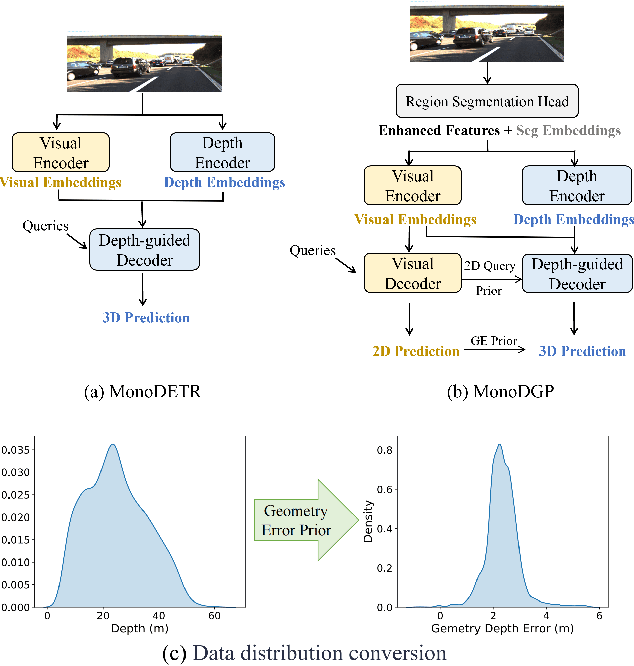
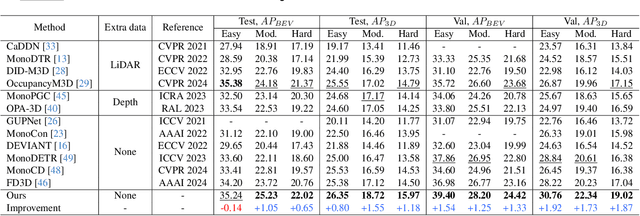
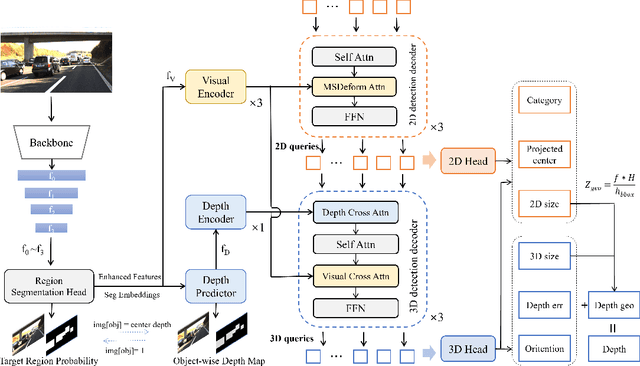
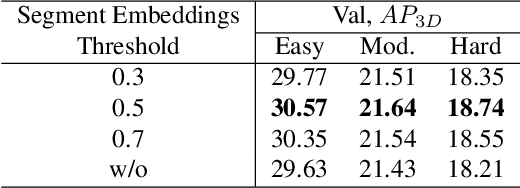
Perspective projection has been extensively utilized in monocular 3D object detection methods. It introduces geometric priors from 2D bounding boxes and 3D object dimensions to reduce the uncertainty of depth estimation. However, due to depth errors originating from the object's visual surface, the height of the bounding box often fails to represent the actual projected central height, which undermines the effectiveness of geometric depth. Direct prediction for the projected height unavoidably results in a loss of 2D priors, while multi-depth prediction with complex branches does not fully leverage geometric depth. This paper presents a Transformer-based monocular 3D object detection method called MonoDGP, which adopts perspective-invariant geometry errors to modify the projection formula. We also try to systematically discuss and explain the mechanisms and efficacy behind geometry errors, which serve as a simple but effective alternative to multi-depth prediction. Additionally, MonoDGP decouples the depth-guided decoder and constructs a 2D decoder only dependent on visual features, providing 2D priors and initializing object queries without the disturbance of 3D detection. To further optimize and fine-tune input tokens of the transformer decoder, we also introduce a Region Segment Head (RSH) that generates enhanced features and segment embeddings. Our monocular method demonstrates state-of-the-art performance on the KITTI benchmark without extra data. Code is available at https://github.com/PuFanqi23/MonoDGP.
Long-Tailed Out-of-Distribution Detection via Normalized Outlier Distribution Adaptation
Oct 28, 2024One key challenge in Out-of-Distribution (OOD) detection is the absence of ground-truth OOD samples during training. One principled approach to address this issue is to use samples from external datasets as outliers (i.e., pseudo OOD samples) to train OOD detectors. However, we find empirically that the outlier samples often present a distribution shift compared to the true OOD samples, especially in Long-Tailed Recognition (LTR) scenarios, where ID classes are heavily imbalanced, \ie, the true OOD samples exhibit very different probability distribution to the head and tailed ID classes from the outliers. In this work, we propose a novel approach, namely normalized outlier distribution adaptation (AdaptOD), to tackle this distribution shift problem. One of its key components is dynamic outlier distribution adaptation that effectively adapts a vanilla outlier distribution based on the outlier samples to the true OOD distribution by utilizing the OOD knowledge in the predicted OOD samples during inference. Further, to obtain a more reliable set of predicted OOD samples on long-tailed ID data, a novel dual-normalized energy loss is introduced in AdaptOD, which leverages class- and sample-wise normalized energy to enforce a more balanced prediction energy on imbalanced ID samples. This helps avoid bias toward the head samples and learn a substantially better vanilla outlier distribution than existing energy losses during training. It also eliminates the need of manually tuning the sensitive margin hyperparameters in energy losses. Empirical results on three popular benchmarks for OOD detection in LTR show the superior performance of AdaptOD over state-of-the-art methods. Code is available at \url{https://github.com/mala-lab/AdaptOD}.
Swin-BERT: A Feature Fusion System designed for Speech-based Alzheimer's Dementia Detection
Oct 09, 2024



Speech is usually used for constructing an automatic Alzheimer's dementia (AD) detection system, as the acoustic and linguistic abilities show a decline in people living with AD at the early stages. However, speech includes not only AD-related local and global information but also other information unrelated to cognitive status, such as age and gender. In this paper, we propose a speech-based system named Swin-BERT for automatic dementia detection. For the acoustic part, the shifted windows multi-head attention that proposed to extract local and global information from images, is used for designing our acoustic-based system. To decouple the effect of age and gender on acoustic feature extraction, they are used as an extra input of the designed acoustic system. For the linguistic part, the rhythm-related information, which varies significantly between people living with and without AD, is removed while transcribing the audio recordings into transcripts. To compensate for the removed rhythm-related information, the character-level transcripts are proposed to be used as the extra input of a word-level BERT-style system. Finally, the Swin-BERT combines the acoustic features learned from our proposed acoustic-based system with our linguistic-based system. The experiments are based on the two datasets provided by the international dementia detection challenges: the ADReSS and ADReSSo. The results show that both the proposed acoustic and linguistic systems can be better or comparable with previous research on the two datasets. Superior results are achieved by the proposed Swin-BERT system on the ADReSS and ADReSSo datasets, which are 85.58\% F-score and 87.32\% F-score respectively.
AMPLE: Emotion-Aware Multimodal Fusion Prompt Learning for Fake News Detection
Oct 21, 2024Detecting fake news in large datasets is challenging due to its diversity and complexity, with traditional approaches often focusing on textual features while underutilizing semantic and emotional elements. Current methods also rely heavily on large annotated datasets, limiting their effectiveness in more nuanced analysis. To address these challenges, this paper introduces Emotion-\textbf{A}ware \textbf{M}ultimodal Fusion \textbf{P}rompt \textbf{L}\textbf{E}arning (\textbf{AMPLE}) framework to address the above issue by combining text sentiment analysis with multimodal data and hybrid prompt templates. This framework extracts emotional elements from texts by leveraging sentiment analysis tools. It then employs Multi-Head Cross-Attention (MCA) mechanisms and similarity-aware fusion methods to integrate multimodal data. The proposed AMPLE framework demonstrates strong performance on two public datasets in both few-shot and data-rich settings, with results indicating the potential of emotional aspects in fake news detection. Furthermore, the study explores the impact of integrating large language models with this method for text sentiment extraction, revealing substantial room for further improvement. The code can be found at :\url{https://github.com/xxm1215/MMM2025_few-shot/
Reliable Heading Tracking for Pedestrian Road Crossing Prediction Using Commodity Devices
Oct 08, 2024



Pedestrian heading tracking enables applications in pedestrian navigation, traffic safety, and accessibility. Previous works, using inertial sensor fusion or machine learning, are limited in that they assume the phone is fixed in specific orientations, hindering their generalizability. We propose a new heading tracking algorithm, the Orientation-Heading Alignment (OHA), which leverages a key insight: people tend to carry smartphones in certain ways due to habits, such as swinging them while walking. For each smartphone attitude during this motion, OHA maps the smartphone orientation to the pedestrian heading and learns such mappings efficiently from coarse headings and smartphone orientations. To anchor our algorithm in a practical scenario, we apply OHA to a challenging task: predicting when pedestrians are about to cross the road to improve road user safety. In particular, using 755 hours of walking data collected since 2020 from 60 individuals, we develop a lightweight model that operates in real-time on commodity devices to predict road crossings. Our evaluation shows that OHA achieves 3.4 times smaller heading errors across nine scenarios than existing methods. Furthermore, OHA enables the early and accurate detection of pedestrian crossing behavior, issuing crossing alerts 0.35 seconds, on average, before pedestrians enter the road range.
Anomaly Resilient Temporal QoS Prediction using Hypergraph Convoluted Transformer Network
Oct 23, 2024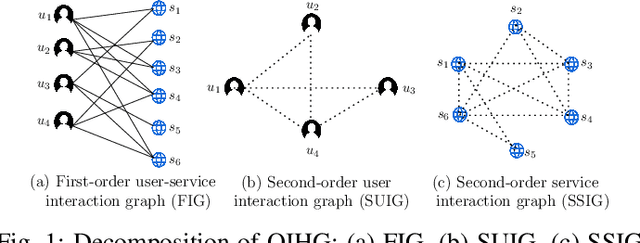
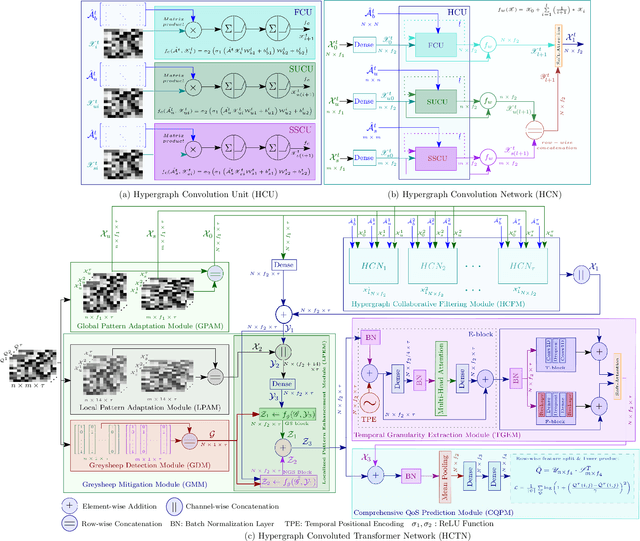

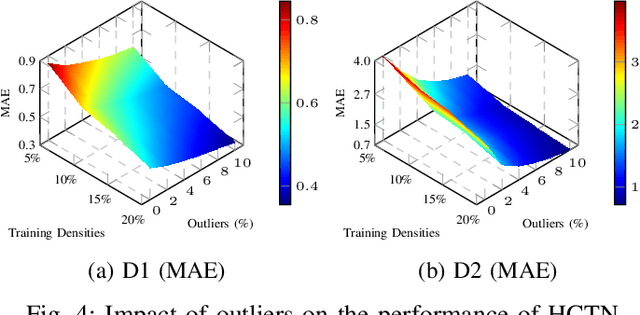
Quality-of-Service (QoS) prediction is a critical task in the service lifecycle, enabling precise and adaptive service recommendations by anticipating performance variations over time in response to evolving network uncertainties and user preferences. However, contemporary QoS prediction methods frequently encounter data sparsity and cold-start issues, which hinder accurate QoS predictions and limit the ability to capture diverse user preferences. Additionally, these methods often assume QoS data reliability, neglecting potential credibility issues such as outliers and the presence of greysheep users and services with atypical invocation patterns. Furthermore, traditional approaches fail to leverage diverse features, including domain-specific knowledge and complex higher-order patterns, essential for accurate QoS predictions. In this paper, we introduce a real-time, trust-aware framework for temporal QoS prediction to address the aforementioned challenges, featuring an end-to-end deep architecture called the Hypergraph Convoluted Transformer Network (HCTN). HCTN combines a hypergraph structure with graph convolution over hyper-edges to effectively address high-sparsity issues by capturing complex, high-order correlations. Complementing this, the transformer network utilizes multi-head attention along with parallel 1D convolutional layers and fully connected dense blocks to capture both fine-grained and coarse-grained dynamic patterns. Additionally, our approach includes a sparsity-resilient solution for detecting greysheep users and services, incorporating their unique characteristics to improve prediction accuracy. Trained with a robust loss function resistant to outliers, HCTN demonstrated state-of-the-art performance on the large-scale WSDREAM-2 datasets for response time and throughput.
MMHead: Towards Fine-grained Multi-modal 3D Facial Animation
Oct 10, 2024



3D facial animation has attracted considerable attention due to its extensive applications in the multimedia field. Audio-driven 3D facial animation has been widely explored with promising results. However, multi-modal 3D facial animation, especially text-guided 3D facial animation is rarely explored due to the lack of multi-modal 3D facial animation dataset. To fill this gap, we first construct a large-scale multi-modal 3D facial animation dataset, MMHead, which consists of 49 hours of 3D facial motion sequences, speech audios, and rich hierarchical text annotations. Each text annotation contains abstract action and emotion descriptions, fine-grained facial and head movements (i.e., expression and head pose) descriptions, and three possible scenarios that may cause such emotion. Concretely, we integrate five public 2D portrait video datasets, and propose an automatic pipeline to 1) reconstruct 3D facial motion sequences from monocular videos; and 2) obtain hierarchical text annotations with the help of AU detection and ChatGPT. Based on the MMHead dataset, we establish benchmarks for two new tasks: text-induced 3D talking head animation and text-to-3D facial motion generation. Moreover, a simple but efficient VQ-VAE-based method named MM2Face is proposed to unify the multi-modal information and generate diverse and plausible 3D facial motions, which achieves competitive results on both benchmarks. Extensive experiments and comprehensive analysis demonstrate the significant potential of our dataset and benchmarks in promoting the development of multi-modal 3D facial animation.
Detecting Unforeseen Data Properties with Diffusion Autoencoder Embeddings using Spine MRI data
Oct 14, 2024



Deep learning has made significant strides in medical imaging, leveraging the use of large datasets to improve diagnostics and prognostics. However, large datasets often come with inherent errors through subject selection and acquisition. In this paper, we investigate the use of Diffusion Autoencoder (DAE) embeddings for uncovering and understanding data characteristics and biases, including biases for protected variables like sex and data abnormalities indicative of unwanted protocol variations. We use sagittal T2-weighted magnetic resonance (MR) images of the neck, chest, and lumbar region from 11186 German National Cohort (NAKO) participants. We compare DAE embeddings with existing generative models like StyleGAN and Variational Autoencoder. Evaluations on a large-scale dataset consisting of sagittal T2-weighted MR images of three spine regions show that DAE embeddings effectively separate protected variables such as sex and age. Furthermore, we used t-SNE visualization to identify unwanted variations in imaging protocols, revealing differences in head positioning. Our embedding can identify samples where a sex predictor will have issues learning the correct sex. Our findings highlight the potential of using advanced embedding techniques like DAEs to detect data quality issues and biases in medical imaging datasets. Identifying such hidden relations can enhance the reliability and fairness of deep learning models in healthcare applications, ultimately improving patient care and outcomes.
 Add to Chrome
Add to Chrome Add to Firefox
Add to Firefox Add to Edge
Add to Edge